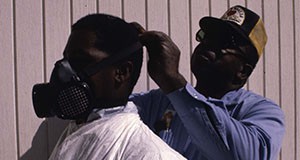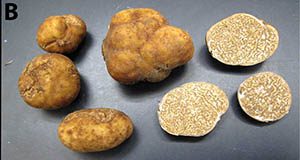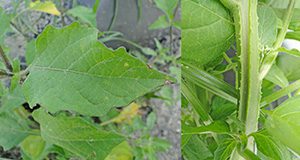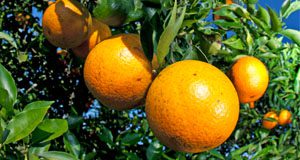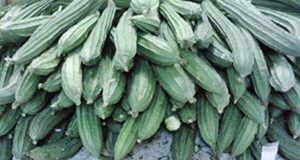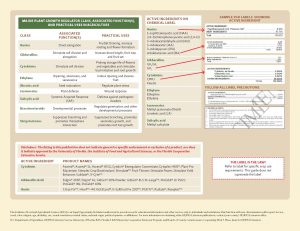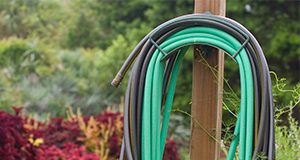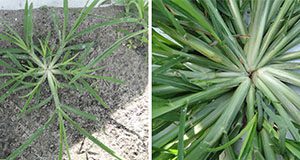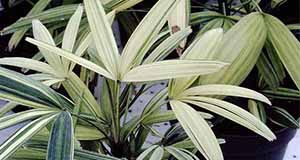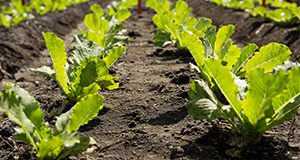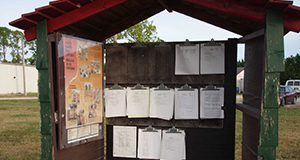
This three-page FAQ fact sheet answers questions about posting information at a central location per the regulations of the Worker Protection Standard (WPS).
Written by Frederick M. Fishel and Tatiana Sanchez and published by the Agronomy Department.
http://edis.ifas.ufl.edu/pi149
Author: Allison Nick
Worker Protection Standard: Certified Crop Advisor Exemption
In 1992, the US Environmental Protection Agency (EPA) issued a comprehensive regulation called the Worker Protection Standard for Agricultural Pesticides (WPS). The EPA has made several changes to the WPS since it was fully implemented in 1995. On November 2, 2015, the EPA made significant changes to the rule’s requirements. Most of the revised provisions will become effective January 2, 2017 and there are four provisions that are delayed until January 2, 2018. This five-page fact sheet answers questions regarding changes made to the exemptions for Certified Crop Advisors. Written by Frederick M. Fishel and Tatiana Sanchez and published by the Agronomy Department.
http://edis.ifas.ufl.edu/pi265
Worker Protection Standard: Notification and Hazard Communication
In 1992, the US Environmental Protection Agency (EPA) issued a comprehensive regulation called the Worker Protection Standard for Agricultural Pesticides (WPS). The EPA has made several changes to the WPS since it was fully implemented in 1995. On November 2, 2015, the EPA made significant changes to the rule’s requirements. Most of the revised provisions will become effective January 2, 2017 and there are four provisions that are delayed until January 2, 2018. This five-page fact sheet answers questions regarding changes made to the rules about notification and hazard communication. Written by Frederick M. Fishel and Tatiana Sanchez, and published by the Agronomy Department.
http://edis.ifas.ufl.edu/pi266
Worker Protection Standard: Owner and Immediate Family Exemption
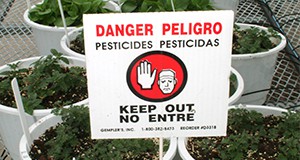
This three-page FAQ fact sheet answers questions about the exemptions for owners and their immediate families in the Worker Protection Standard (WPS).
Written by Frederick M. Fishel and Tatiana Sanchez and published by the Agronomy Department.
http://edis.ifas.ufl.edu/pi264
2016 Florida Blueberry Integrated Pest Management Guide
This 37-page fact sheet provides extensive information about integrated pest management for growing blueberry plants in Florida. Writteny by Jeffrey G. Williamson, Philip F. Harmon, Oscar E. Liburd, and Peter Dittmar and published by the Horticultural Sciences Department.
http://edis.ifas.ufl.edu/hs380
Worker Protection Standard: Personal Protective Equipment (PPE) 2016
In 1992, the US Environmental Protection Agency (EPA) issued a comprehensive regulation called the Worker Protection Standard for Agricultural Pesticides (WPS). The EPA has made several changes to the WPS since it was fully implemented in 1995. On November 2, 2015, the EPA made significant changes to the rule’s requirements. Most of the revised provisions will become effective January 2, 2017 and there are four provisions that are delayed until January 2, 2018. This five-page fact sheet answers questions regarding changes made to the rules about Personal Protective Equipment (PPE). Written by Frederick M. Fishel and published by the Agronomy Department.
http://edis.ifas.ufl.edu/pi267
The Pecan Truffle (Tuber lyonii): A Gourmet Truffle Native to the Southeastern United States
A truffle is a round, knobby, or lobed mushroom fruiting body that forms below ground. The “pecan truffle” (Tuber lyonii) is an edible truffle species, native to eastern North America. This fungus lives in a mutually beneficial relationship with the roots of some trees, including species of oak, hazelnut, and hickory trees, as well as the cultivated pecan tree. This four-page fact sheet describes the pecan truffle, its economic and culinary significance, morphology, and phenology and distribution. Written by Arthur C. Grupe II, Timothy Brenneman, Gregory Bonito, and Matthew E. Smith and published by the Plant Pathology Department.
http://edis.ifas.ufl.edu/pp330
Biology and Management of American Black Nightshade (Solanum americanum P. Mill.) in Tomato, Pepper, Cucurbit, and Strawberry
This three-page fact sheet describes the biology and management of American black nightshade, explaining how to control for it in tomato and pepper, cucurbits, and strawberry. Written by Nathan S. Boyd, Shawn Steed, Chris Marble, and Andrew MacRae and published by the Horticultural Sciences Department.
http://edis.ifas.ufl.edu/hs1176
Planting and Annual Cultural Maintenance Costs for Reset-Replacement Trees in a Florida Citrus Grove in 2016
Replacement of diseased, unproductive or dead trees is an important part of the cultural program for citrus groves. This five-page fact sheet uses prices and productivity rates collected through a telephone survey in May 2016 to analyze the different preferred management and reset practices. Written by Marina Burani-Arouca, Stephen H. Futch, and Ariel Singerman and published by the Food and Resource Economics Department.
http://edis.ifas.ufl.edu/fe995
Using Personality Type Preferences to Enhance Team Work in Extension Programs
This three-page fact sheet, the fifth in a series on teaching different personality types, covers the practical ways in which Extension professionals can use the influence of personality type preferences to enhance team dynamics in Extension program development and implementation. This article will cover the Myers-Briggs personality type indicator, True Colors personality type indicator, and the Kirton Adaption Innovation Inventory. Written by J. Brianne Bird, Alexa J. Lamm, and Hannah Carter and published by the Department of Agricultural Education and Communication.
http://edis.ifas.ufl.edu/wc269
Matrix Ranking: A Tool for Decision-Making and Prioritization
Matrix ranking is an activity used to analyze and prioritize information. Extension professionals often work with community groups who may benefit from this type of analysis. This four-page fact sheet explains how Extension professionals can use matrix ranking to facilitate prioritization and decision-making. Written by Keegan Gay, Eric Stubbs, and Sebastian Galindo-Gonzalez and published by the Department of Agricultural Education and Communication.
http://edis.ifas.ufl.edu/wc239
Reporting Clientele Contacts in Workload
Each fall UF/IFAS faculty are asked to report on their Extension activities and accomplishments over the past year, including the contact made with Extension clientele through both direct and indirect methods. This five-page fact sheet describes how to report these interactions in Workload. Written by Diane Craig and Glenn D. Israel and published by the Department of Agricultural Education and Communication.
http://edis.ifas.ufl.edu/wc058
Luffa: an Asian Vegetable Emerging in Florida
Luffa is the genus name of several tropical and subtropical plants in the cucumber family. Alternatively spelled “Loofa” or “Loofah,” the name is derived from the plant’s use as a material for sponges and dish cloths for bathing and cleaning dishes. This six page fact sheet describes the two types of Luffa, how to cultivate them, and what they can be used for. Written by Yucong Xie, Guodong Liu, Yuncong Li, and Kati Migliaccio and published by the Horticultural Sciences Department.
http://edis.ifas.ufl.edu/hs1285
Quick Reference Guide: for Plant Growth Regulators (PGR) in Florida Citrus Production
A new two-page fact sheet explains Plant Growth Regulators (PGRS) and their application and use in Florida citrus production. Written by T. Vashisth and J.D. Burrow and published by the Horticultural Sciences Department.
http://edis.ifas.ufl.edu/hs1284
Biology and Management of Ragweed Parthenium (Parthenium hysterophorous L.) in Ornamental Crop Production
This six-page fact sheet provides an overview of Ragweed Parthenium, Parthenium hysterophorous L, including a species description and information on how to manage ragweed parthenium culturally, physically, and chemically. Written by Debalina Saha, Chris Marble, Robert H. Stamps, and Shawn Steed and published by the Environmental Horticulture Department.
http://edis.ifas.ufl.edu/ep531
Engaging High Water Users in Water Conservation #3: High Water Users' Opportunities to Learn about Water Conservation
Homeowners who use excessive amounts of water to irrigate their landscapes have specified demographic characteristics and have been identified as high water users. This three-page fact sheet is the third in a series discussing how Extension can improve high water users' engagement in water conservation, focusing on how to effectively communicate with high water users about water conservation education. Written by Pei-wen Huang and Alexa J. Lamm and published by the Department of Agricultural Education and Communication.
http://edis.ifas.ufl.edu/wc257
Biology and Management of Goosegrass (Eleusine indica (L.) Gaertn.) in Tomatoes, Peppers, Cucurbits, and Strawberries
This four-page fact sheet gives a brief description of the biology and management of goosegrass, a common annual turf and horticultural weed found throughout Florida that grows well in compact, wet soils and superficially resembles crabgrasses. Written by Nathan S. Boyd, Kiran Fnu, Chris Marble, Shawn Steed, and Andrew W. MacRae and published by the Horticultural Sciences Department.
http://edis.ifas.ufl.edu/hs1178
Rhapis excelsa: Lady Palm
Rhapsis excelsa, the lady palm, is an outstanding, small clustering palm for shady landscape or interiorscape use. This two page fact sheet gives a brief overview of the Lady Palm. Written by Timothy K. Broschat and published by the Environmental Horticulture Department.
http://edis.ifas.ufl.edu/fp501
Trends in Rice Production and Varieties in the Everglades Agricultural Area
Rice production in the Everglades Agriculture Area (EAA) of Florida dates back nearly seven decades. For a brief period in the 1950s about 2,000 acres of rice was grown in the EAA. Rice was reintroduced in the EAA in 1977 after it was demonstrated that rice could be successfully incorporated into the sugarcane production cycle during the fallow period. This three-page fact sheet provides a history of rice production in Florida and information about rice varieties grown in Florida. Written by Jehangir H. Bhadha, Luigi Trotta, and Matthew VanWeelden and published by the Soil and Water Sciences Department.
http://edis.ifas.ufl.edu/ss653
Organic Management of Vegetable Diseases, Part II: Foliar Pathogens
The successful management of both soilborne and foliar diseases requires a multifaceted program, taking into consideration variety selection, cultural methods, biologicals, and chemical applications approved by the Organic Materials Review Institute (OMRI) and certified organic under the United States Department of Agriculture (USDA) National Organic Program (NOP). This review emphasizes the management of foliar disease and serves as a guide to assist growers in selecting strategies to manage disease in a sustainable system. Written by Gary Vallad and published by the Department of Plant Pathology.
http://edis.ifas.ufl.edu/pp170
